In this day and age, pretty much everyone from toddlers to grandparents owns at least one pair of jeans, but not every pair of jeans suits every person! With so many different types of jeans to choose from, you may end up with a pair that isn’t quite right for you. When that happens, you may find yourself wondering how to fade jeans to change the color or texture to suit your tastes.
The best way to fade jeans quickly is to apply a solution of bleach and water or hydrogen peroxide and water. For a gradual fading process, using hot-water washes or leaving the jeans in the sun will do the trick. Other popular fading methods include applying sandpaper, salt, or vinegar.
In this article, you will learn what makes denim fade so easily. You will discover eight easy methods for fading jeans to your desired color. Finally, you will find tips on how to fade jeans evenly!
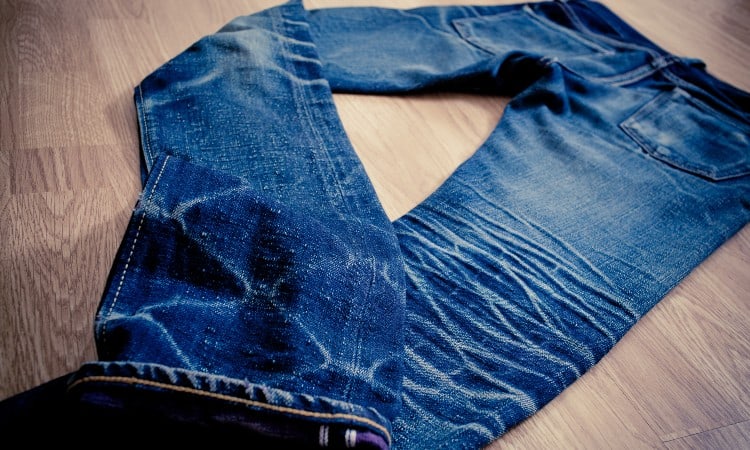
What Makes Jeans Fade?
Traditional blue jeans fade because of the type of indigo dye treatment used to make denim fabric. Even if you care for your jeans properly, they will eventually fade over time just from wear! Understanding how and why jeans fade will help you restyle your own denim if you decide to go that route.
Denim is made out of 100% cotton woven into a special twill pattern. The other unique thing about this material is that it uses two different colors of threads, one set of threads dyed blue with indigo dye and one set left plain white. The blue and white threads interlace to make the familiar blue-grey color we know and love!
The indigo dye used for denim starts as a powder dissolved into a special solution. It sticks to the cotton threads through a process called oxidation, which only dyes the outer surface of the thread. This is called ring-dyeing.
Because only the outer portion of the thread turns blue, the blue can wear away over time, leaving the white at the thread’s core visible. This is what caused fading in traditional blue denim.
But what about black, stretch, or prewashed jeans?
First, take a look at the difference between raw denim and prewashed or pre-faded denim.
Before you try to fade your jeans at home, you should figure out if you have raw denim or prewashed denim on your hands. These days brands like Levis sell dozens of different colors, fades, and finishes for every cut of jeans in their catalog. If you buy jeans that have already received special treatment, you may damage them by applying bleach or another fading solution!
Raw denim means 100% indigo and white cotton twill without any special treatments. Raw denim will display the most pronounced, dramatic fading if you apply any of the methods in this article because you will see the surface-level indigo dye fade or disappear. Prewashed denim has already gone through a variety of treatments and will not fade as dramatically.
Manufacturers use a combination of washing in water, chemical treatments, and various abrasive techniques to give jeans a burnished, faded, or softened appearance. Most of the time, you can find info on this prewashing treatment by reading the product description in detail before you make a purchase.
The main thing to keep in mind about fading pre-washed jeans is that you will likely remove the finish on the surface of the pants by fading them further. For example, if the denim has a shiny texture from an abrasive treatment, you will probably strip away that surface finish with your fading process.
Stretch jeans are a whole nother ball of wax, as the saying goes! With skinny jeans now popular for both men and women, stretch denim has seen a huge rise in popularity in the past decades. This type of denim contains anywhere from 1% to 5% of an elastic fiber such as spandex blended into the cotton threads.
Spandex does not do well with heat, bleach, or other strong fading agents. Stretch denim almost always receives treatments to make it resist fading and often takes longer to respond to any of the methods described in this article. On top of that, you have to handle it carefully, so you don’t destroy its elasticity!
All of that said, you can fade or scuff up your stretch jeans to get just the right style for you. You just have to approach the process with a little more caution.
Black denim does not fade in the same way as blue denim. This is because manufacturers use a different type of dye that soaks through the white cotton threads for black jeans. Fading black jeans usually means physically removing some of the black dye, leaving a grey color behind.
Depending on the nature of your jeans, the black dye may leach out pretty easily in the wash. The difference between a raw denim fade and a black denim fade is that with black denim, you don’t get the cool white-thread contrast peeking through. Instead, you get grey denim!
Once you know what kind of denim your jeans contain and what type of pretreatment it has received, you can decide whether or not you want to apply one of the eight easy fading methods provided here!
How to Fade Jeans: 8 Best Methods
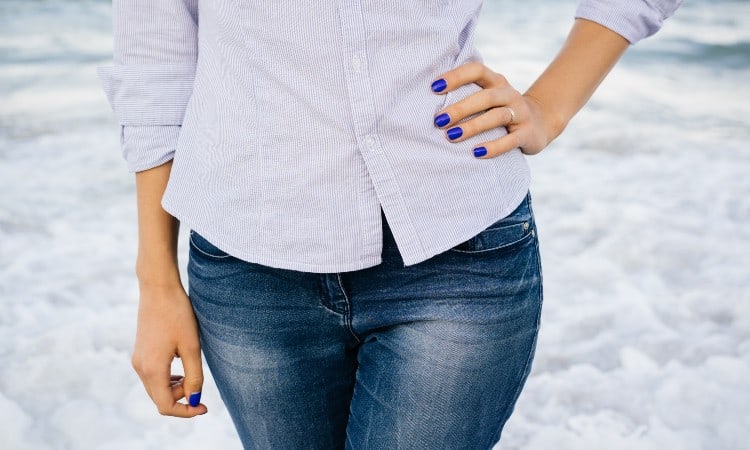
Now that you have decided to fade your jeans, you have to select a fading method that fits the style you want to achieve. The good news is that you can use common household products or even just simple old sunlight to get the look you want!
The bad news is that it’s tricky to guarantee a precise, even fade to exactly the shade you intend. Make sure you read the pros and cons of each method to find one that will suit you!
1. Bleach
 The biggest advantage to using bleach to fade your jeans is that it is by far the quickest and most effective fading method. The downside is that bleach damages synthetic fibers and will reduce the stretch recovery of stretch denim significantly.
The biggest advantage to using bleach to fade your jeans is that it is by far the quickest and most effective fading method. The downside is that bleach damages synthetic fibers and will reduce the stretch recovery of stretch denim significantly.
You also have to consider what type of bleach you should use.
Chlorine bleach works effectively to fade the denim but has some drawbacks. First, it will not turn the denim white–prolonged exposure tends to turn denim yellow instead. Second, if you don’t remove all of the bleach after the treatment, it can continue to dissolve the denim!Oxygen bleach will fade jeans but will not totally remove color in the powerful way chlorine bleach does. You may find this a safer but slower alternative if you want to try bleaching denim.
Finally, as you learned earlier, you need to consider what type of jeans you’re working with. Bleach really will damage stretch jeans, so you might want to try another method for those!
Follow these steps to safely bleach denim:
- First, protect yourself and your workspace by making sure you have good ventilation. Use plastic sheeting or a cheap dollar store tablecloth to cover up your floor. Wear rubber gloves to keep your hands safe and goggles if you’re worried about splashing chemicals.
- Fill a large bucket with two gallons of cool water. You don’t want to use your bathtub or sink as the leaching dye could stain them!
- Measure in two cups of bleach and use a spoon or your gloves hand to stir the solution.
- Carefully submerge your jeans in the water.
- Let the jeans soak for as long as thirty minutes, but lift them out and rearrange them in the bucket every five minutes to make sure you get even bleaching.
- Carefully press the wet jeans above the bucket to get out as much liquid as possible. Then place the jeans into another container and carry them to your washing machine.
- Wash as usual in cool water with laundry detergent.
- Let your jeans air-dry, and then examine the finished result to see if you like how much the denim faded!
Alternatively, if you want to control the evenness of the fade, you can apply the bleach and water using a spray bottle. You will need to take extra steps to protect yourself and your workspace if you do this, though! Make sure you don’t accidentally spray bleach onto a carpet or furniture if you use this method.
2. Without Bleach
You can use quite a few fading methods without bleach, but one of the safest no-bleach methods is to treat your jeans with lemon juice! Did you ever highlight your hair with lemon juice in the summer as you sat by the neighborhood pool? Well, lemon juice works on denim in much the same way!
Lemon juice contains a high concentration of citric acid, which brightens white clothes and fades colored fabrics. This all-natural product is safe to use and can prove effective, but you will not see the instant, dramatic change in color you get from using bleach.
You will want to buy bottled lemon juice for this method. You would have to squeeze a lot of lemons to get enough juice to soak your jeans!
Try these steps to apply lemon juice to your denim clothing:
- fill a bucket with about two gallons of cool water, leaving enough space for your jeans to fit in.
- Soak the jeans and then lift them out and roll them up to remove most of the water.
- Empty the bucket down the drain and refill it with enough lemon juice to fully submerge your jeans. You will probably need at least two large bottles of juice from the grocery store.
- Carefully lower your damp jeans into the juice.
- You will need to soak your jeans for a good while. Check on the color every fifteen to twenty minutes until you start to see fading take place.
- When you like the look of the fade, carefully remove your jeans from the juice and roll them up to press out excess liquid. Then place them in a clean container to carry over to your washing machine.
- Run the jeans through a regular cool-water washing cycle. You will probably see a bit more fading after this!
- You can safely dispose of lemon juice down the drain, but pour it carefully, so it doesn’t splash dye onto your tub or sink!
3. Hydrogen Peroxide
 Like bleach, hydrogen peroxide can remove the dye from denim. Peroxide also oxidizes the dye particles and allows them to break free from the fabric. It does not work as fast as bleach, but it is the best method for getting a white fade instead of an ugly yellow color. The downside is that, like bleach, peroxide can damage synthetic fibers and may cause your stretch jeans to have less elasticity.
Like bleach, hydrogen peroxide can remove the dye from denim. Peroxide also oxidizes the dye particles and allows them to break free from the fabric. It does not work as fast as bleach, but it is the best method for getting a white fade instead of an ugly yellow color. The downside is that, like bleach, peroxide can damage synthetic fibers and may cause your stretch jeans to have less elasticity.
Some jean experts recommend soaking denim in hydrogen peroxide after other fading treatments to ensure a good white fade. As a pro tip, you can also use peroxide in your laundry to brighten your white sheets, towels, and shirts!
Before you begin, please note that you can purchase hydrogen peroxide in many different strengths. Check the percentage of peroxide in the mixture on the label. A greater percentage of peroxide makes the solution more effective and more dangerous for you, so wear gloves as necessary!
You can use a soak, sponge, or spray method to apply hydrogen peroxide to denim:
- Hydrogen peroxide does not have toxic fumes like bleach, but you should still work with a fan or open window nearby.
- For the soak method, fill a bucket with cool water and add two cups of peroxide. Submerge the jeans and let them soak for 15 minutes. If they look faded enough, run them through the wash to rinse away the peroxide.
- For the spray method, fill a spray bottle with a solution of water and peroxide, using more peroxide for a stronger fade and less for a weaker fade. Arrange your jeans on a clean, white towel and spritz away! You can easily achieve a splattered or galaxy-like design using this method, but make sure you wash the jeans as soon as you finish to remove the peroxide.
- For the sponge method, put on some rubber gloves and soak a sponge directly in peroxide. Dab the sponge onto your jeans to create a smudged fade pattern. Then rinse the jeans in the wash when you finish!
4. Sun
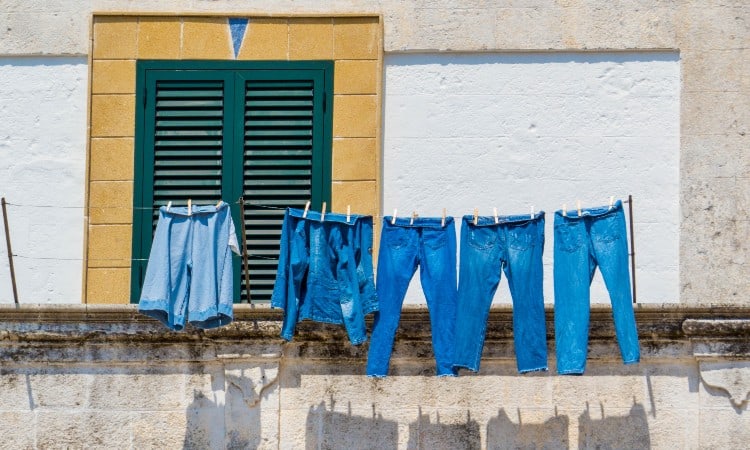
It takes a while, but the ultimate all-natural way to fade your jeans is to set them outside in the sun! Prolonged exposure to the sun will fade most natural fabric though some synthetic materials can resist its unforgiving rays.
Fading your denim in the sun is super easy. All you have to do is wash the jeans in cold water and either hang them on an outdoor clothesline or spread them flat on a clean bedsheet spread out in your yard.
The tough part of this process is that you may have to repeat the wash and outdoor dry multiple times. If you have dark denim, you will see some change pretty quickly. Paler denim may not fade as dramatically all at once.
5. Sandpaper
Sanding your jeans creates one of the coolest, most stylized faded looks of all! The risk in this method is that it does eat away at the denim fibers and can weaken the jeans, meaning that they may not last quite as long.
You can get varying effects by using different types of sandpaper, but using 180 grit paper or a pumice stone will give a good basic result. If you want a ripped look, you may want to use grittier sandpaper.
- First, set up your jeans to avoid any unintended scuffing. If you plan to sand the legs, insert a piece of folded cardboard inside the legs, so you don’t damage the back of the leg while working on the front. Likewise, if you want to scuff up the front pockets, place a piece of cardboard inside the waistband to protect the back.
- You may want to wear outdoor work gloves to protect your hands from the sandpaper as well. If you have ever sanded over your own finger, you know how painful it feels!
- Next, try scraping the sandpaper lightly with the grain of the denim. You will see a slightly fuzzy, whiter mark where you sanded if you have blue jeans. On black jeans, you will get a grey fade mark.
- Try applying varying levels of pressure and broader or shorter sanding strokes to find out what level of faded marks you like!
- When you finish sanding your jeans, wash them in the washing machine to rinse away any clinging fuzz or dye.
6. Salt
 Using salt and vigorous stirring to abrade the denim can cause your jeans to fade. This process takes a bit more manual labor than you might expect, so prepare yourself if you want to give it a try!
Using salt and vigorous stirring to abrade the denim can cause your jeans to fade. This process takes a bit more manual labor than you might expect, so prepare yourself if you want to give it a try!
Like sandpaper, salt can roughen and abrade denim, causing the fibers to loosen and displaying the white core of blue denim. On black jeans, you will probably get a grey fade with this technique, though washing in hydrogen peroxide as an after-treatment could brighten the fade!
To fade your jeans using salt:
- Find a large bucket or basin capable of holding seven gallons.
- Fill it up to the five-gallon mark, and then measure in two cups of table salt.
- Submerge your jeans in the saltwater.
- Let them soak for two days, but make sure you stir them briskly regularly! If you can, once an hour is ideal. Obviously, you need to sleep, though, so just stir the jeans vigorously as often as possible!
- Remove the jeans from the saltwater with care and have a clean container handy to haul them to your washing machine. Wash as usual in cool water to remove the salt.
7. Washing Machine
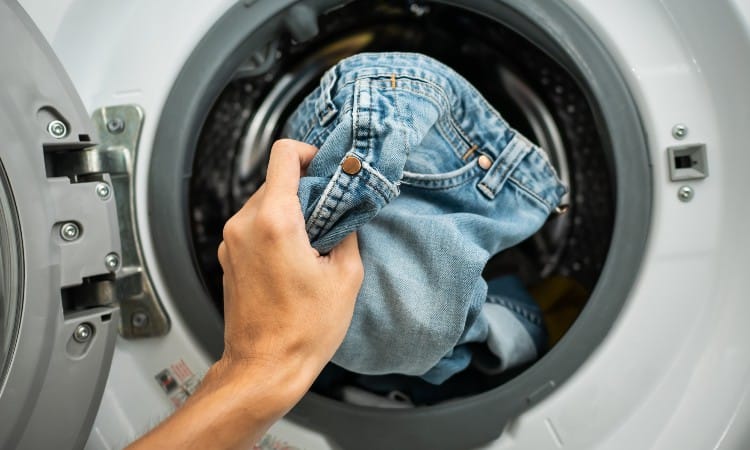
All jeans fade over time in the wash. The benefit of letting your denim fade gradually is that this gentle treatment will soften the fabric but will not weaken or damage its fibers. The con is that it takes a while!
Some jeans get pretreatments that help prevent fading in the wash. Raw denim often comes with warnings that you should not wash it for the first six months, as it could lose a lot of dye all at once!
Hot water will fade denim much faster than cool water, but it will also make your jeans shrink. Cotton shrinks easily when exposed to moisture, so this is a risky move to make!
The safest way to fade your jeans in the wash is to use cold water settings. Using laundry detergent tends to speed up the fading process a bit. If you want to avoid fading your jeans, experts recommend leaving out the detergent and using vinegar instead!
How long will it take for your jeans to fade in the wash? This depends on how dark they are, to begin with! On average, you can expect to see some fading after three to four months of active wearing and washing.
8. Wear
The absolute safest way to fade jeans without damaging them is to let them wear out gradually over time! If you have stretch jeans, you may especially want to consider this method.
As a fun fact, you can find info on special fade patterns such as the “honeycomb” and the “whiskers,” that develop naturally on your jeans as you wear them! Fade marks that build up on pockets especially get a lot of buzz in the denim world.
Heavyweight denim shows pronounced marks more quickly than lighter-weight denim. Likewise, blue denim display more clear fade marks than black denim.
Here’s the catch, though: you need to give your jeans a solid year to develop these personal, worn-in fade marks!
How Do You Lighten Dark Jeans?
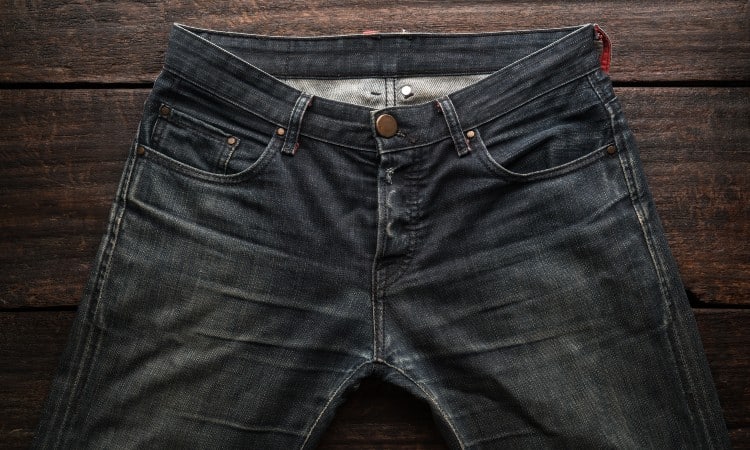
You can lighten dark jeans with a bleach soak, frequent wearing, or abrasion. Soaking will lighten the denim all over. Wearing and abrading the fabric can fade specific spots for a stylized look.
To learn how to bleach jeans safely, check out the section on the bleach method earlier in this article! Keep in mind that chlorine bleach will harm your jeans more easily but will also lighten them super quickly. Also, bleaching works better on raw denim than on black denim or stretch denim.
You can just go about your daily life in your jeans and then wash them in your washing machine to see a gradual lightening over time. If you want to speed up this process, try wearing your jeans around the house inside out! This extra bit of abrasion will fade the denim to a lighter color more quickly.
Finally, you can use intentional abrasion to create lighter areas on certain spots, such as the pockets and seat. This gives your jeans a more vintage look! You can use sandpaper, a pumice stone, or even a handful of coffee beans to rub on the denim for this faux-vintage style.
How to Fade and Soften Blue Jeans
New jeans often have a stiff texture that doesn’t feel great, but you can easily fade and soften the stiff denim by washing it in vinegar and drying it in the sunshine!
On its own, vinegar does not fade jeans. Instead, it makes the denim more dye-fast! But it does soften the fibers in the denim.
This trick works great for new jeans and makes sure your line-dry jeans don’t go as stiff as a board!
Simply fill a bucket with eight cups of water and one cup of distilled white vinegar. Let your jeans soak in this solution overnight before you wash them as usual. Then hang them up to dry in the sunlight outside!
They will not fade a lot under this treatment, but you will instantly notice the softer texture!
How Do You Fade Jeans Quickly?
The quickest way to fade or lighten your jeans is to use the bleach method. Bleach uses oxidation to release oxygen molecules that break up the color chromosomes in dye. In practical terms, it turns dye particles white!
This powerful chemical reaction will quickly fade your jeans. It does run the risk of damaging the fabric, though. You may also find it tricky to get an even fade using this fast process.
How Can You Fade Jeans Evenly?
It’s hard to bleach jeans evenly, but finding a way to spread them out flat while they soak in bleach can do the trick! You can also try using a spray bottle to apply bleach because this gives you more control over the bleah application.
If you use the bleach bucket method described earlier in this article, one way to ensure an even fade is to stir the jeans in the bucket regularly. This exposes all parts of the denim to bleach.
If you don’t mind running the risk of dying your bathtub black or blue, you can fill it up with five parts water to one part bleach. Then spread your jeans out so that every part is smooth and unwrinkled in the bleach water. Let them sit for fifteen minutes before removing the jeans and washing them in your washing machine.
Using a spray bottle to spritz bleach water over your jeans lets you control how much bleach hits each part of the denim. This process is much more labor-intensive, though!
Why Do Blue Jeans Fade in the Wash?
Water and detergent remove the blue or black dye in denim over time, causing the jeans to fade. If you do not want your jeans to fade, you can use several methods to prevent fading in jeans.
First, you can avoid washing your jeans altogether! Some brands like Levis promote the idea of spot-cleaning your jeans instead of putting them in the washing machine.
Second, you can use a mild detergent and cold water in the washing machine and air dry your jeans away from direct sunlight.
Finally, you can wash your jeans in a solution of water and vinegar to get them clean and prevent fading.
If you do decide to wash your jeans, you should never use hot water. Hot water fades denim more quickly than cold water. It can also make your jeans shrink!
Conclusion
Whether you have black jeans or blue jeans, old jeans or new jeans, you may decide that you want a stylish faded look for your denim wardrobe! You can easily fade your jeans using bleach, hydrogen peroxide, or all-natural products like lemon juice. You can use salt water or sandpaper to abrade faded patches onto your jeans, giving them a retro look at key points like the pockets or seat.
If you want a more gradual, lived-in fade, you can simply wear your jeans into a lighter color, or try wearing them inside ut to speed up the fading process! You can also wash them repeatedly to lighten the color of the denim or allow them to dry in direct sunlight for a natural fade.
Have you ever tried to fade a pair of jeans? How did it go? Leave a comment below to let us know!